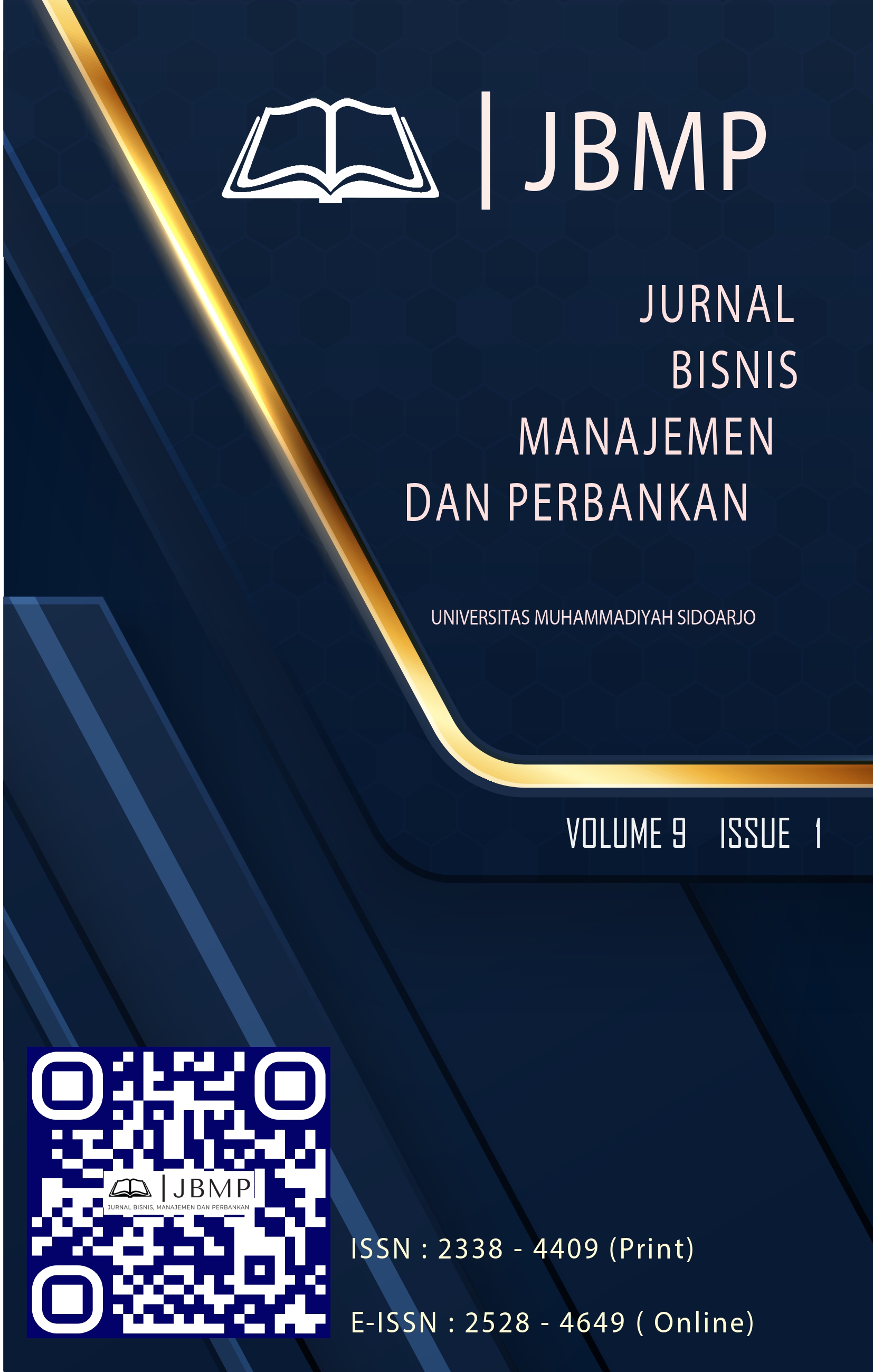The Pecking Order Theory Perspective in the Study of Company Capital Structure (Study On Manufacturing Companies On The Indonesia Stock Exchange)
DOI:
https://doi.org/10.21070/jbmp.v9i1.1643Keywords:
capital structure, profitability, liquidity, company sizeAbstract
A balanced combination of own capital and debt is the main key to optimal capital structure in a corporation. At any given time, the management team in the company will show you a targeted capital structure, which may be optimal, althought that target may change from time to time. Several factors influence the company’s capital structure decisions such as Profitability, Liquidity and Company Size. This study was used to measure the impact of profitability, liquidity and firm size on the capital structure of manufacturing companies on the Indonesian stock exchange for the period 2018-2021 using the pecking order theory method. The population used in this study is manufacturing companies listed on the Indonesia Stock Exchange. Sampling method used targeted sampling method and obtained his 40 samples from Indonesian Stock Exchange-listed manufacturing companies in the period 2018-2021. Analysis of the data used is multiple linear regression analysis using the SPSS application. Simultaneously the results obtained from this study are the variables of Profitability, Liquidity and Company Size have a significant effect on Capital Structure.
References
Agustini, T. (2015). Effect of Asset Structure, Profitability, and firm size on Capital Structure Journal of Management Science and Research 4(8).
Chasanah, N. W., & Budhi , S. (2017). The Effect of Profitability, Liquidity and firm size on the Capital Structure of Transportation Companies. Journal of Management Science and Research 6(7).
Habibah, M. (2015). Analysis of the Effect of Profitability, Asset Structure , Liquidity, and Sales Growth on Capital Structure. Journal of Accounting Science and Research Vol. 4, No. 7, 1- 15.
Ichwan, F. Y. (2015). Effect of firm size, Asset Structure and Profitability on Capital Structure. Journal of Accounting Science & Research Vol. 4. No. 6, 1-19.
Kumar, S. (2017). Research on Capital Structure Determinants: A Review and Future Directions.International Journal of Managerial Finance Vol. 13, No. 2, 106-131.
Nastiti, R. D. (2016). Effect of Asset Structure, Liquidity, Profitability, firm size, Sales Growth On Capital Structure. Journal of Accounting Science and Research Vol. 5, No. 1, 1-17.
Prasetya, B. T. (2014). Effect of Profitability, firm size , Growth Opportunity, Liquidity, Asset Structure , Business Risk and Non Debt Tax Shield on Structure Capital In Consumer Goods Sub-Sector Companies. Journal of Management Science. 2(4), 1341- 1353.
Sholikhadi, L. M. (2016). Factors Affecting the Capital Structure of Cosmetic and Household Purposes Companies on the IDX. Journal of Management Science and Research Vol. 5, No. 7, 1-17.
Thausyah, N. F. (2015). The Effect of Sales Growth, Asset Structure, and Profitability on Capital Structure. Journal of Management Science and Research 4(9), 1-15.
Vani, O. V. (2019). The Effect of Business Risk and firm size on The Capital Structure of Manufacturing Companies Listed on the Indonesia Stock Exchange With Profitability as an Intervening Variable. 1-86.
Wahyuni, I., & Lilis, A. (2017). Effect of Growth Opportunity, Profitability, and Dividend Policy on Capital Structure . Journal of Accounting Science and Research 6(4), 1308-1325.
Wikartika, I. (2017). Testing Pecking Order Theory In Jakarta Islamic Index. Neo-Bus, Volume 11, No.1, June 2017, 1-12.
Darsono dan Ashari. 2005. Pedoman Praktis Memahami : Laporan Keuangan. Edisi 1. Andi. Yogyakarta
Kartini dan Tulus Arianto. 2008. ”Struktur Kepemilikan, Profitabilitas, Pertumbuhan Aktiva dan Ukuran Perusahaan terhadap Struktur Modal pada Perusahaan Manufaktur”. Jurnal Keuangan dan Perbankan. Vol. 12. No. 1. Januari 2008. Hal. 11 – 21. Universitas Islam Indonesia. Yogyakarta.
Saidi. 2002. “Faktor-Faktor yang Mempengaruhi Struktur Modal Pada Perusahaan Manufaktur Go Public Di BEJ Tahun 1997 – 2002”. Jurnal Bisnis dan Ekonomi. Vol. 11. No. 1. Maret. Hal. 44 – 58. STIE Stikubank. Semarang.
Sartono, Agus. 2001. Manajemen Keuangan : Teori Dan Aplikasi. Edisi Keempat. Cetakan Pertama. BPFE. Yogyakarta.
Sugiyono. 2005. Metode Penelitian Bisnis. Cetakan Kedelapan. CV Alfabeta. Bandung
Devi, Ni Made Noviana Chintya dkk, 2017, Pengaruh Struktur Aktiva, Profitabilitas, Ukuran Perusahaan, Likuiditas Dan Kepemilikan Manajerial Terhadap Struktur Modal Perusahaan, Vol 7 N0 1 2017, Jurnal Ilmiah Mahasiswa Akuntansi Undhiksa
Hafidzah, Zila Nurdila, Roni Malavia Mardani, dan Budi Wahono, 2019, Pengaruh Profitabilitas, Struktur Aktiva, Dan Ukuran Perusahaan Terhadap Struktur Modal (Studi Pada Perusahaan Perbankan yang Terdaftar di BEI periode 2015-2017), Vol. 8 , 21 Agustus 2019, Jurnal Ilmiah Riset Manajemen.
Istiqomah, Nur Ayu ,Riana R Dewi, dan Suhendro, 2020, Pengaruh Struktur Aktiva, Ukuran Perusahaan, Profitabilitas, Dan Resiko Bisnis Terhadap Struktur Modal Pada Perusahaan Manufaktur Yang Terdaftar di Bursa Efek Indonesia 2013-2017, Vol.2, No.1 (2019), Proseding Seminar Nasional Akuntansi Universitas Pamulang.
Lasut, Stenyverens J.D, Paulina Van Rate, dan Michael Ch. Raintung, 2018 Pengaruh Ukuran Perusahaan, Profitabilitas, Dan Likuiditas Terhadap Struktur Modal Pada Perusahaan Otomotif Yang Terdaftar Di Bursa Efek Indonesia Periode 2012-2015, Vol. 6, No.1 (2018), Jurnal Emba
Pebriyanti, Ni Kadek Dwi,I Wayan Sukadana, dan I Wayan Widnyana, 2020, Pengaruh Profitabilitas, Struktur Aktiva, Dan Ukuran Perusahaan Terhadap Struktur Modal Pada Perusahaan Manufaktur Yang Terdaftar di Bursa Efek Indonesia, Vol.1 No.1 (2020), ISSN : 2774-3020, Jurnal Emas
Supeno, Bambang, Roni Putra Adi, 2019 Pengaruh Struktur Aktiva, Ukuran Perusahaan, Dan Profitabilitas Terhadap Struktur Modal Pada Perusahaan Farmasi Yang Terdaftar Pada Bursa Efek Indonesia, Vol. 1 No.1 (2019) , Jurnal manajemen Dan Bisnis Terapan.
Tangiduk, Desmianti, Paulina Van Rate, dan Johan Tumiwa, 2017, Analisis Pengaruh Ukuran Perusahaan, Struktur Aktiva, Dan Profitabilitas Terhadap Struktur Modal Pada Perusahaan Manufaktur Sektor Industri Dasar Dan Kimia Yang Terdaftar di Bursa Efek Indonesia Periode 2011-2015, Vol. 5, No.2 (2017), Jurnal Emba.








